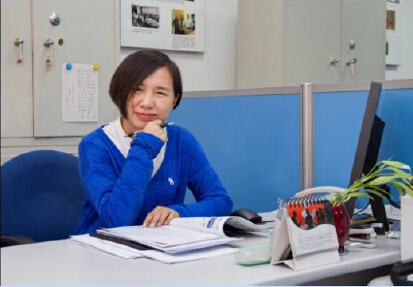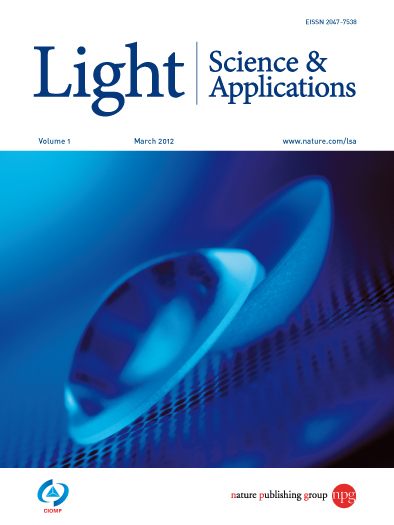
EURAXESS country representative Andrea Strelcova had an interview with Prof. BAI Yuhong who is the director of Editorial Department of CIOMP. The interview was published in the EURAXESS Links China Newsletter on Oct.31, 2014.
 |
| BAI Yuhong, director of Editorial Department of CIOMP (Image by CIOMP) |
The interview demonstrated the work of CIOMP female staff as well as provided a window to display CIOMP and its English journal Light: Science & Application to the outside world, which is a good opportunity to bridge CIOMP and researchers abroad to cooperate in the future.
Bai Yuhong was born in Changchun, China. She received a BSc degree in electronic engineering from Jilin University, a MSc degree in optical engineering from Chinese Academy of Sciences and a PhD in management science and engineering from Dalian University of Technology. She joined the Changchun Institute of Optics, Fine Mechanics and Physics (CIOMP), Chinese Academy of Sciences (CAS), as an assistant professor in 1986, and was appointed full professor in 2005. She is the Director of Publication Department of CIOMP.
Dear Prof Bai, can you tell us a bit about your work?
I am in charge of five optics journals published by CIOMP, one of them being an English journal co-published with Nature Publishing Group (NPG) called Light: Science & Applications (LSA). In my work, I have been focusing on bridging a gap between strong Chinese academic literature and foreign science.
Why and where can you see a gap between Chinese and foreign academic literature?
A gap exists especially in certain fields where the country excels, such as optics and materials, etc., and where data from China have been so far overlooked. For example, CIOMP has done some great work in optical engineering, but we have never had many papers published in English. Now, because the journal is co-published with NPG, more and more overseas scientists notice us, pay a visit, and feel amazed by our work. This helps us pursue more international collaboration.
How does CIOMP contribute to world’s research in optics?
In the different phases of China’s development, CIOMP has always played a crucial role in meeting the needs of the nation, its social environment and research requirements. Currently, the R&D activities of CIOMP largely focus on applied research to solve the current problems in engineering and industry. This means that there is less forward-looking, pioneering and original work when compared to some other countries. Nevertheless, China continues to develop quickly, and there is a strong desire to reach out to the world and fully participate with colleagues from all countries in all aspects of optics and photonics research. Pursuing more international collaboration is also what has led to the launch of Light: Science & Applications.
 |
| Light: Science & Applications (LSA), Established in 2012, LSA is published by CIOMP in cooperation with Nature Publishing Group (NPG). LSA publishes high quality optics and photonics research from around the world. The journal covers fundamental research and important issues in applied science and engineering. You can learn more and subscribe on www.nature.com/lsa/. |
What does your typical day as a Managing Director of an academic journal involve?
Half of my time is spent on the road travelling around the world and China to attend various international conferences and promote the LSA’s internationalization strategy. The rest of the time I stay in my office. I have meetings with my staff, discussing what is hot and who is popular in the optics community. I also spend a lot of time reading manuscripts, especially comments from the reviewers. Of course, reading and writing e-mails is an essential part of my daily life, no matter where I am. I do a lot of coordination work, with our topical editors around the world, to control the quality of the journal. And although I don’t have time to do research anymore, I still spare some time to teach. I give lectures on how to publish a scientific paper or on journalism and communication in science.
Where would you like to see your work develop?
I was behind the idea of initiating the LSA, and it has been a long way before we finally launched the journal in 2012. Now, I would like to see our work further develop and modernize. We already know that a bright future is waiting for us not only in China but also around the world. As an open-access journal, it brings us into the 21st century through a model which is increasingly popular in Western journals. LSA provides a medium for the dissemination and exchange of knowledge and ideas with colleagues all over the world. In turn, this inspires future research.
What does the rise of international journals co-published in China such as LSA say about the change of Chinese research environment?
The share of international journals published or co-published in China on global research publications is rising rapidly. There are more than 120 such academic journals, mainly with Springer, Elsevier, Wiley, Oxford and NPG. Although to be honest, the research community and the government are thinking how to assess and evaluate research in a way that is not based only on publications. A few days ago, the International Symposium on Research Assessment and Evaluation was held in Shanghai. The Editor-In-Chief of Nature, Dr Philip Campbell, 2002 Nobel Chemistry Laureate Kurt Wüthrich and other high-profile personalities from the global and Chinese scene attended the symposium and discussed how to pay more attention to the impact of the research work, not the quantity of the publications. It is an important topic.
What is the impact of researchers’ living and working abroad on global science and technology?
The exchange of scientific knowledge is most successful when such exchange is free and available to all, regardless of geography. My personal experience is that researchers living and working abroad have more opportunities for international scientific and technological exchange and cooperation. It always opens your mind when you work or study abroad, no matter who you are and where you live. The impact on global science and technology is that the processes and the outcomes of research are widely disseminated into the world. Such advancement should not, and cannot, be confined to a few intellectuals in a few areas or countries.
Do you have experience with research in Europe or with European scientists?
I have had too few chances to visit/collaborate with European institutes or universities. But in LSA we have a lot of collaboration with European researchers. Out of 40 editors, 11 come from Europe, and a third of published papers come from European researchers. CIOMP has awarded two honorary professorships to two excellent European researchers; one is Dr. Stefan Kaierle from Laser Zentrum Hannover and the other is Dr. Hans Zappe from University of Freiburg.
How can society best encourage young women who want to pursue a research career?
In my opinion, successful female scientists serving as a role model are the best way to attract young women into science. Society has already done a lot for female scientists. In CIOMP, senior female scientists have equal opportunities and the same retirement regulations as male senior scientists.
Have you ever stumbled upon challenges? Has it been difficult to combine your career with family?
Sure, I have stumbled upon challenges. This is why I changed my job from a full-time researcher gradually into a professional editor. The first time I hit my glass ceiling was back in 1999. During my project, I couldn’t accomplish the results I wanted in the given time, and I felt very frustrated. I questioned my talent as a researcher. Also I had some difficulties in combining my career with my family- my son was young and I would leave for work out of town quite often and sometimes for a long time. I couldn’t sleep well for about a year, and eventually I made up my mind to find a way out. I am satisfied with my career now. I am very happy as a full-time professional editor which is not only my job, but also my hobby.
Prof. Bai, thank you for your time!
I would like to take this opportunity to express my heartfelt thanks to our partners, academic colleagues, and all the staff for their tireless efforts and support to establish this journal. Further, I wish to thank current and future authors and readers for their support, and wish Light: Science & Applications all success!
For more information, please refer to: http://ec.europa.eu/euraxess.

Changchun Institute of Optics, Fine Mechanics and Physics (Image by CIOMP)
The Changchun Institute of Optics, Fine Mechanics and Physics (CIOMP) is the largest CAS institute in China. Founded in 1952, it boasts more than 2,000 full-time staff and nearly 1,000 graduate students. It offers a wide range of master, PhD and post-doc programmes in several disciplines related to optics, fine mechanics and also physics. Originally under the leadership of the first president of Chinese Optical Society Prof. Daheng Wang/Wang Daheng?, CIOMP has undertaken a series of pioneering works across many fields, including applied optics, precision mechanics, lasers and optoelectronics. That is why CIOMP and Changchun has been hailed as “the cradle of optics in China”.

86-10-68597521 (day)
86-10-68597289 (night)

86-10-68511095 (day)
86-10-68512458 (night)

cas_en@cas.cn

52 Sanlihe Rd., Xicheng District,
Beijing, China (100864)

